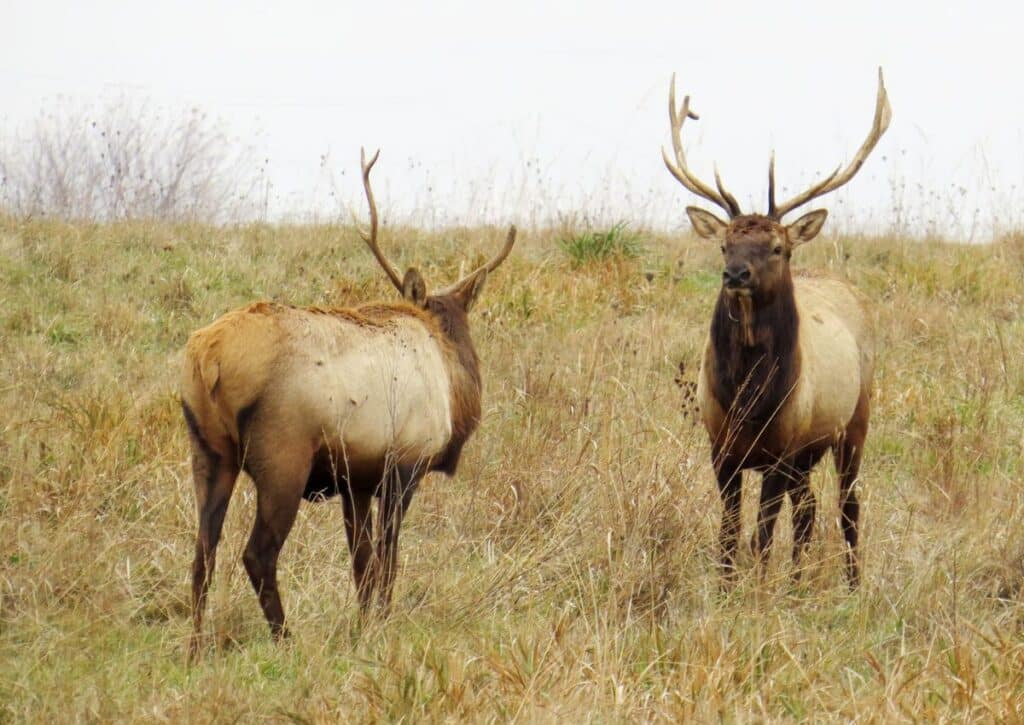Explore 18 animals in Deschutes National Forest during hikes. Discover trails with wildlife sightings, from elk to eagles, for an unmatched experience!
The Deschutes National Forest in the Pacific Northwest is a prime destination for wildlife enthusiasts looking for authentic encounters with diverse species.
Spanning a vast area, this forest is home to a plethora of animals, from majestic birds of prey to stealthy ground predators.
If you’re planning to explore and want to maximize your chances of wildlife sightings, specific trails and regions within the forest are renowned for their animal activity.
Navigating these paths offers not only the thrill of potential wildlife encounters but also insights into the natural habitats and behaviors of these creatures.
For anyone eager to combine hiking with a passion for wildlife observation, the Deschutes National Forest is an unmatched locale, teeming with opportunities.
Wildlife on Hikes in Deschutes National Forest
Hiking in the Deschutes National Forest is a rewarding experience for both its scenic beauty and the abundant wildlife that calls it home.
With every step you take, there’s a chance to encounter creatures from the tiniest insects to the larger, more elusive mammals.
The forest’s diverse terrain, from its dense woodlands to clear riverbanks, attracts a wide range of animals. Bird enthusiasts will find a plethora of species to observe and identify, from predatory raptors like eagles and ospreys to the more common woodland birds.
Mammals like the black bear, mule deer, and the occasional cougar are known inhabitants, although spotting them requires patience and a keen eye.
The water bodies within the forest aren’t just refreshing stops for hikers; they’re also habitats for animals like river otters, minks, and various species of fish.
As you traverse different trails, be it near the water, through the meadows, or in the deeper woods, understanding the wildlife around can enhance your hiking experience.
It’s not just about the physical exercise or the landscapes, but also about connecting with nature in its truest form. For those interested in wildlife, bringing along a field guide or binoculars can be beneficial.
Remember, while the excitement of spotting wildlife is unmatched, it’s essential to maintain a safe distance and respect their natural habitats.
The Deschutes National Forest is their home, and we are but visitors.
Black bears
Black bears possess a stocky frame, with short, strong legs supporting their robust bodies. Their fur can range in color from black to brown, with some even having a hint of blue or white.
Their faces often display a straight profile with a tapered nose. When it comes to their diet, black bears are omnivores, primarily feeding on berries, fruits, nuts, insects, and occasionally, small mammals.
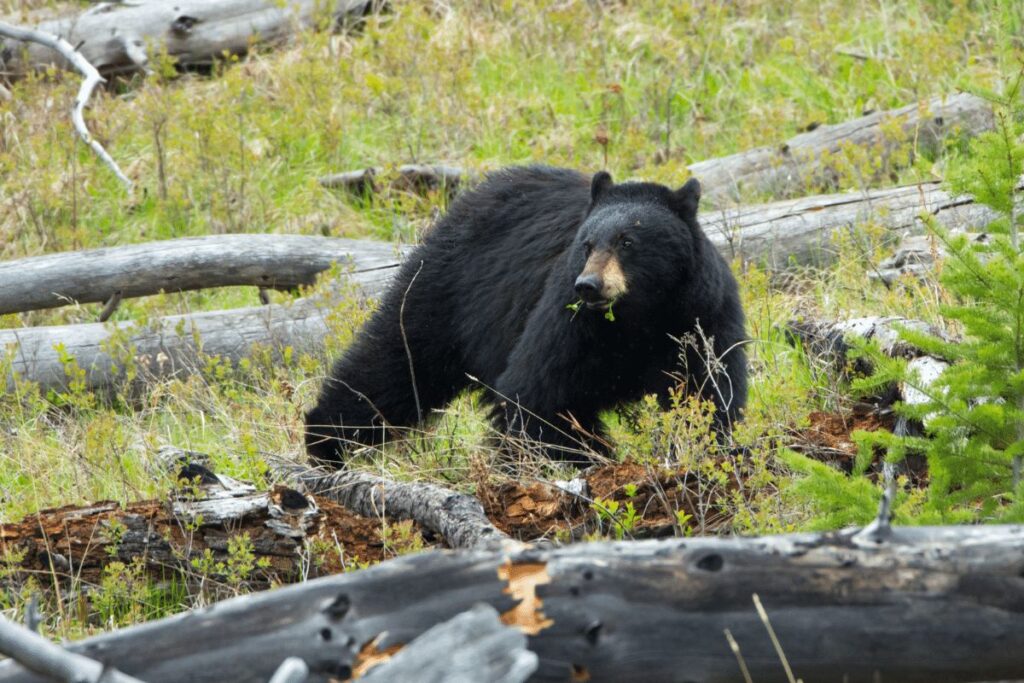
In the Deschutes National Forest, visitors are most likely to spot black bears along the Tumalo Falls trail or near the Metolius River, particularly in remote areas close to berry patches or streams where food is abundant.
An interesting fact about black bears is that despite their intimidating size, they’re excellent climbers, with cubs often scaling trees to evade threats.
Elk
Elk, with their tall, muscular frames, are easily distinguishable in the wild. Males, or bulls, exhibit large, branching antlers that are shed and regrown annually.
Their coats are typically brown, with a cream-colored rump patch and a short, buff-colored mane around their neck. Elk primarily graze, with a diet consisting of grasses, plants, leaves, and bark.
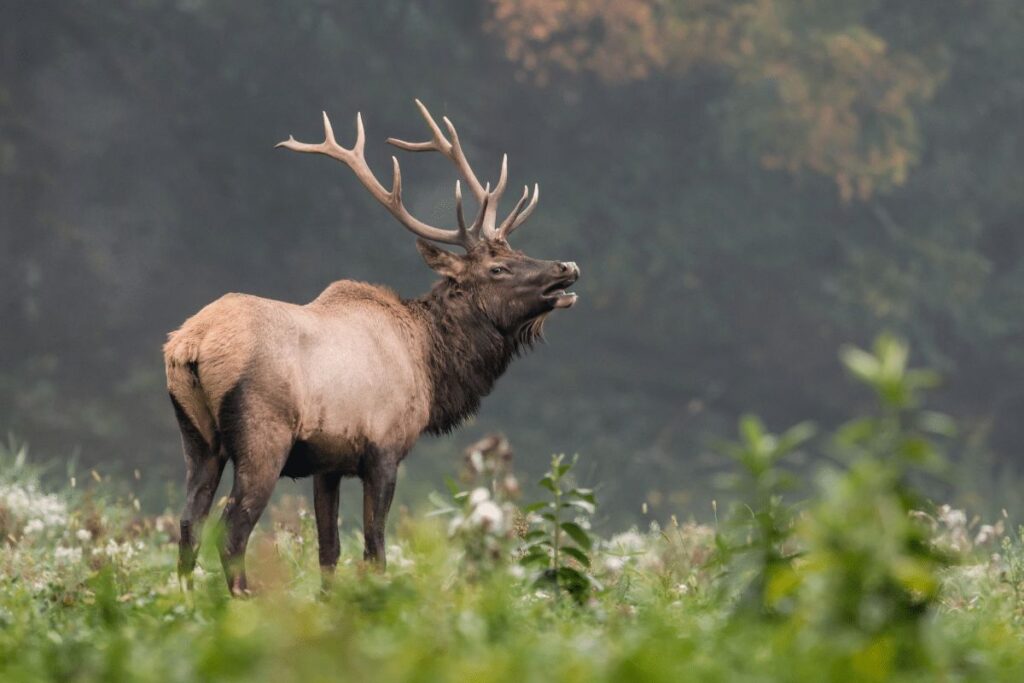
In the Deschutes National Forest, the meadows near the South Sister trail and the grassy expanses of the Green Lakes area serve as prime grazing grounds for elk, especially during dawn and dusk.
An intriguing tidbit about elk is their unique communication method; during the mating season, males emit a high-pitched whistle or bugle, which can be heard over long distances, signaling their presence and strength to potential mates and rivals.
Early morning or evening hours are often the best times to see elk since they are more active during these times of the day. If you do see an elk, be sure to give it plenty of space and do not approach it too closely. Elk are wild animals and can be dangerous if they feel threatened.
Mule deer
Mule deer, named after their large, mule-like ears, have a grace that belies their size.
Their tawny brown coat provides excellent camouflage against the backdrop of forests and shrublands, while the white rump patch, with a black-tipped tail, stands out distinctly.
They have a bifurcated (forked) antler structure, unique among deer species. Mule deer are primarily browsers, feeding on a variety of shrubs, plants, and occasional grasses.
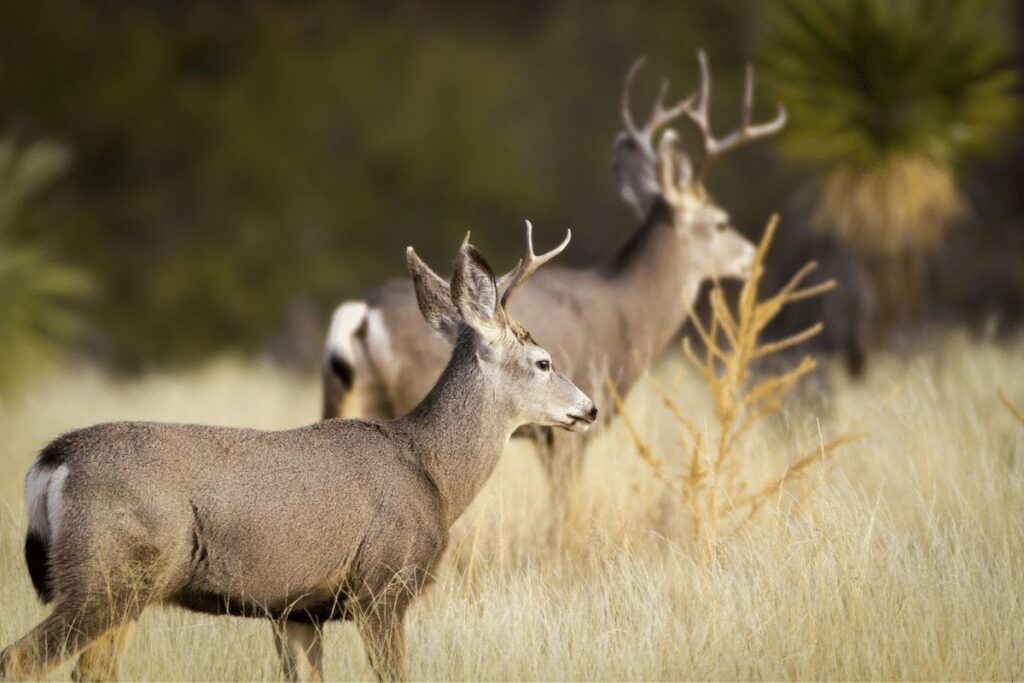
In the summer months, mule deer can be found grazing in open meadows and along the banks of streams and rivers. In the winter, they will move to higher elevations in search of food. During this time they tend to form large herds, making them easier to spot.
In the Deschutes National Forest, visitors have a good chance of spotting these creatures in the early morning or late evening along the Phil’s Trail area or near the Lava Lands Visitor Center.
They often prefer the edges of forests, where woodlands meet open spaces. A captivating aspect of mule deer is their distinctive mode of escape called “stotting” or “pronking,” where they bound with all four feet off the ground, enabling them to quickly navigate rough terrains.
It is important to remember that mule deer are wild animals and should be respected. It is illegal to feed or disturb them in any way. If you happen to see a mule deer while out in Deschutes National Forest, keep your distance and enjoy it from afar.
Bighorn sheep
Bighorn sheep are one of the most popular animals to see in the Deschutes National Forest.
Bighorn sheep are truly emblematic of North America’s mountainous regions. Sporting massive, spiraled horns that can weigh up to 30 pounds in mature rams, these sheep are a sight to behold.
Their brown to grayish-brown coats blend seamlessly with the rocky terrain they inhabit, while the white patches on their muzzle, rump, and belly create a striking contrast.
Bighorn sheep are grazers at heart, feasting on a diet of grasses in the summer and woody plants in the winter.
They are often seen near the Cascade Lakes Highway, in the vicinity of Lava Butte, and along East Rim Drive. While they can be found throughout the forest, these are some of the best places to see them.
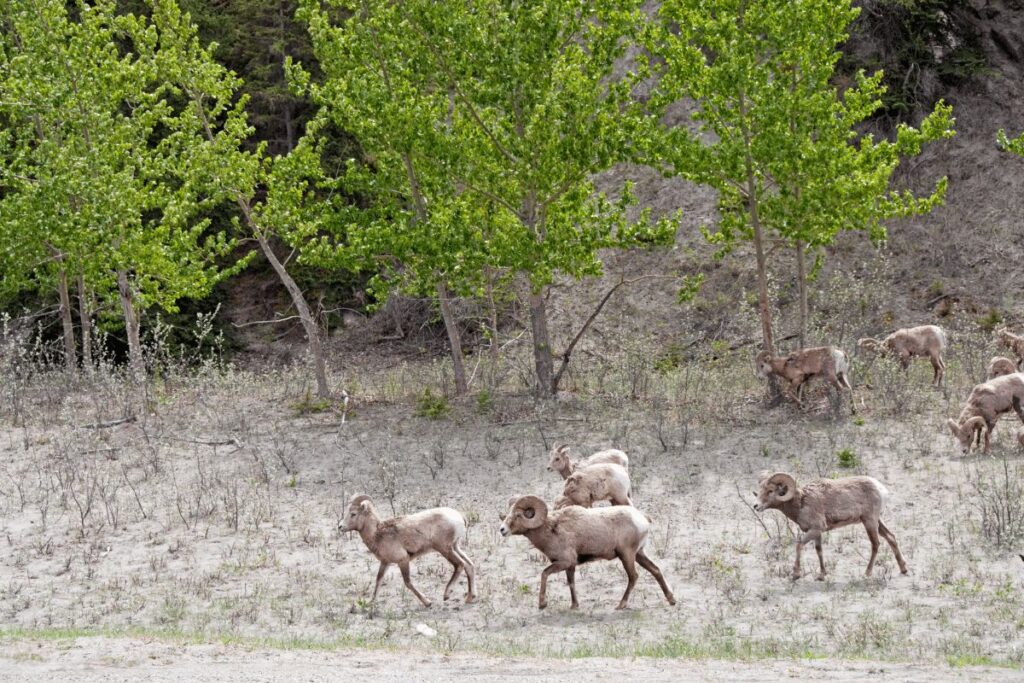
Within the rugged landscapes of the Deschutes National Forest, they are often seen around the Paulina Peak and Tam McArthur Rim areas, scaling steep cliffs and rocky outcrops with an agility that seems almost impossible for their size.
Bighorn sheep are known for their large horns and their ability to climb steep cliffs. They are relatively small animals, standing about 3 feet tall at the shoulder. Bighorn sheep are herbivores and eat a variety of plants.
If you’re lucky enough to see a bighorn sheep in Deschutes National Forest, be sure to give them plenty of space and respect their wild nature.
Pileated woodpeckers
The pileated woodpecker, with its striking appearance, is a testament to nature’s vibrant palette.
Distinguished by its deep black body and bright red crest, it’s one of the largest woodpeckers found in North America. Its white-striped face is accentuated by a powerful beak, designed for vigorous pecking.
The bird primarily feeds on insects like carpenter ants and wood-boring beetle larvae, excavating deep into the bark of dead trees to find its prey.
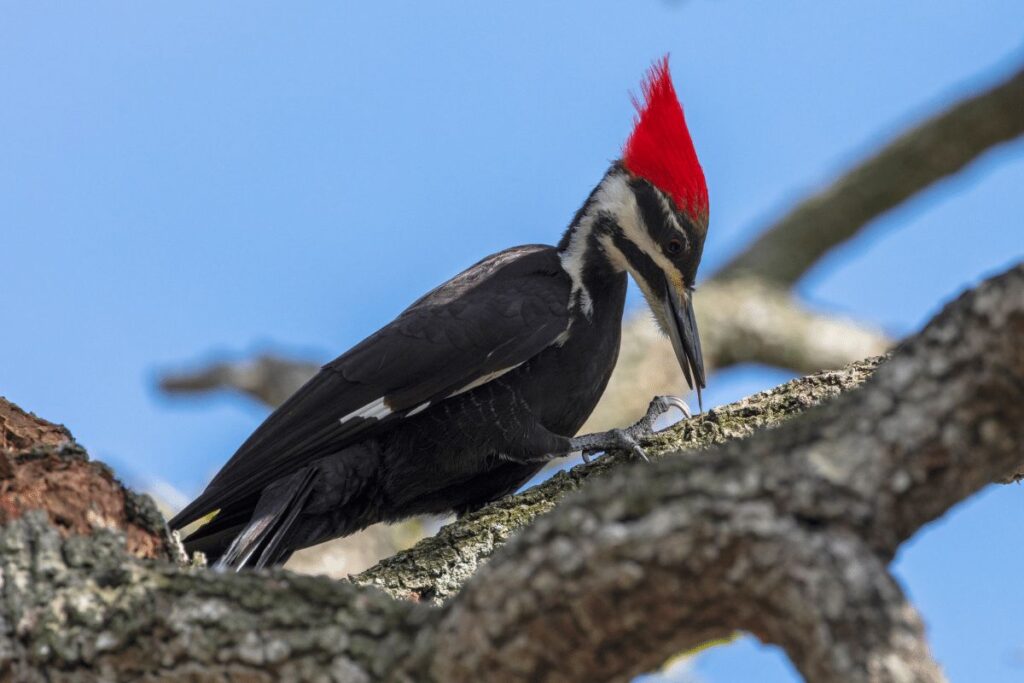
Within the lush canopy of the Deschutes National Forest, these woodpeckers frequent the old-growth sections near the Deschutes River Trail or around the Fall Creek area. Their drumming can often be heard echoing through the forest.
A captivating detail about pileated woodpeckers is the way they carve out large, rectangular cavities in trees, not just for feeding but also for nesting. These cavities, over time, become shelters for various other species.
Martens
Martens, with their slender bodies and glossy fur coats, exude an agile elegance. They display a rich, chocolate-brown fur with a notable creamy or yellow patch on their throat.
These creatures belong to the Mustelidae family, making them relatives of weasels and otters.
They are carnivorous by nature, with a diet consisting of small mammals, birds, insects, and even fruits during certain seasons.
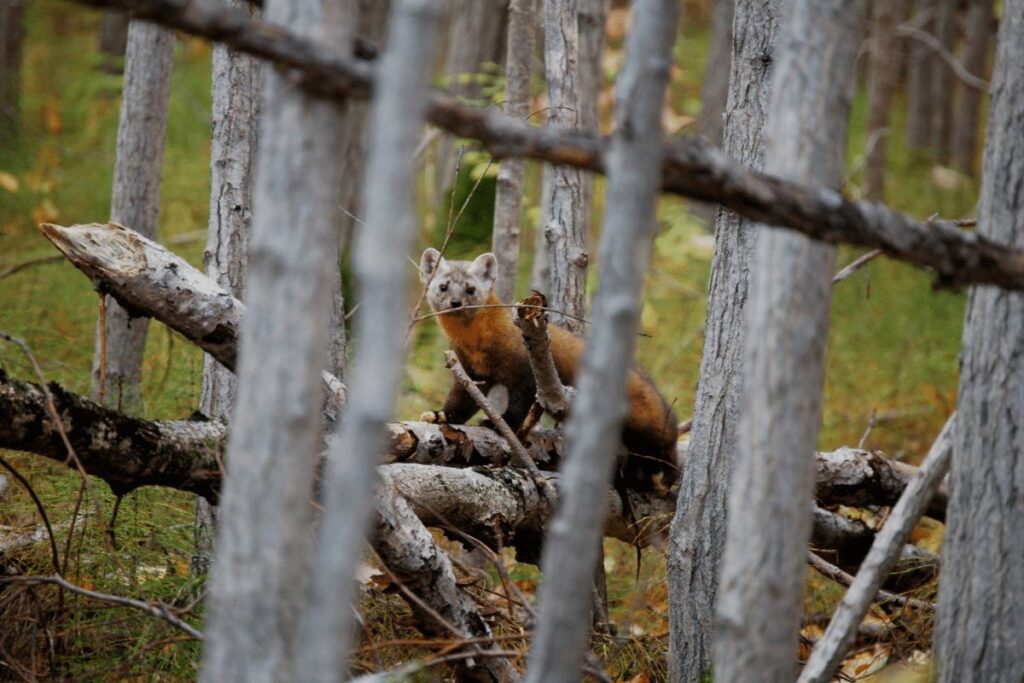
In the Deschutes National Forest, martens can often be spotted darting among the trees in areas like the Cascade Lakes Scenic Byway or the Three Sisters Wilderness, particularly in dense coniferous zones.
An intriguing fact about martens is their adaptability. While they are skilled tree climbers, leveraging this ability to hunt and escape predators, they are equally adept at traversing the forest floor, making them versatile hunters in both terrains.
The best time of year to spot martens is typically from May through October. During this time, they’re most active and more likely to be visible. Be sure to bring binoculars so that you can get a closer look!
Mink
Mink, with their sleek bodies and luxurious fur, exude an air of understated elegance.
These agile mammals possess a dark brown to almost black coat that shines when wet, and their faces are adorned with curious, beady eyes and white patches on the chin.
As carnivorous creatures, minks thrive on a diet of fish, crustaceans, small mammals, and birds. Their semi-aquatic nature allows them to be proficient hunters both on land and in water.
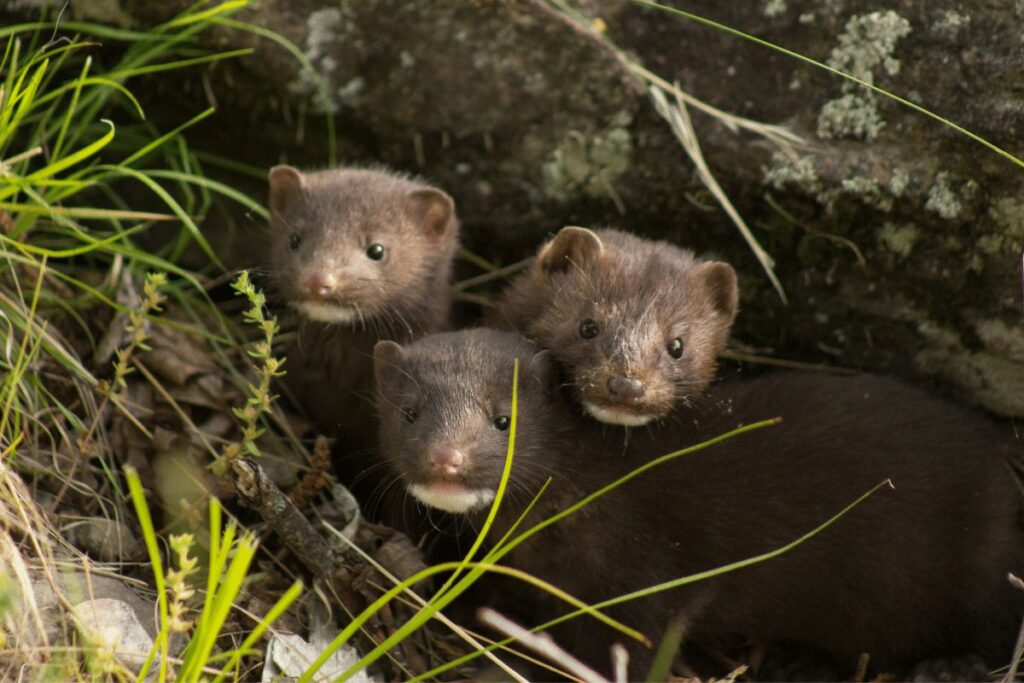
Within the Deschutes National Forest, minks can often be spotted along the water bodies, especially in places like the banks of the Deschutes River or the edges of Sparks Lake. An engrossing detail about mink is their solitary nature.
They are largely territorial and can exhibit fierce behaviors when defending their territory, making them intriguing subjects for wildlife enthusiasts.
River otters
River otters, with their streamlined bodies and playful demeanor, bring a sense of joy to those fortunate enough to spot them.
They have a dense, water-repellent fur that varies from brown to a more golden hue, and their webbed feet and strong tails make them adept swimmers.
Their diet is primarily aquatic-based, feasting on fish, frogs, crustaceans, and occasionally small mammals.
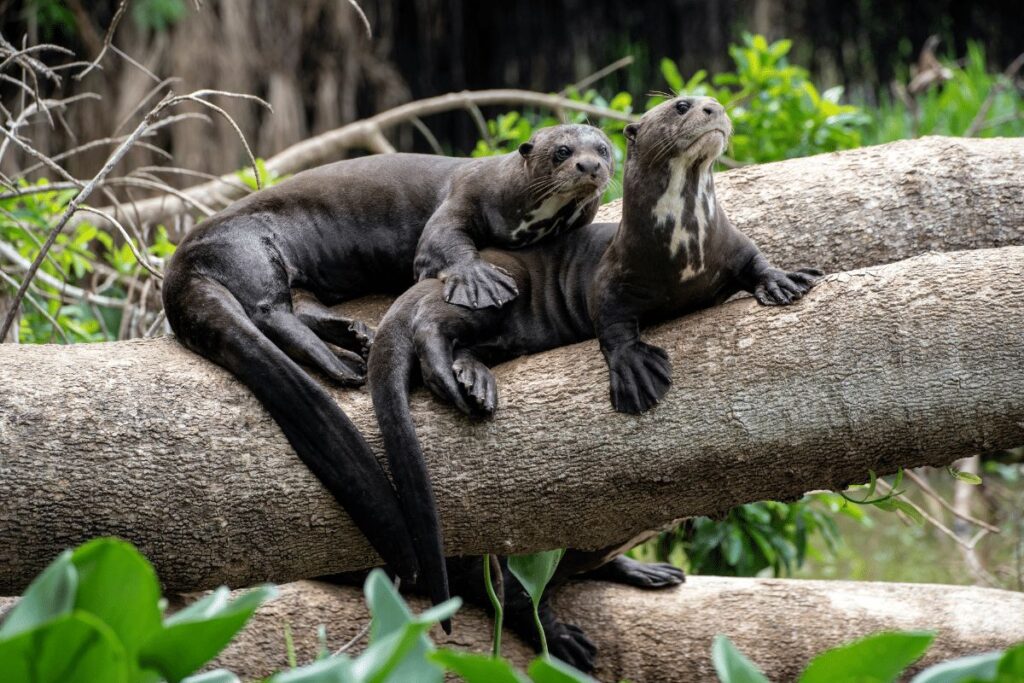
River otters tend to be most active in the early morning or evening hours. If you’re out exploring during these times, keep your eyes peeled for movement along the water’s edge.
The Deschutes National Forest offers a pristine habitat for these otters, particularly in water-rich areas like the Big Lava Lake or the channels flowing near the Tumalo Falls.
An interesting facet of river otters is their communal nature. Unlike their solitary cousin, the mink, river otters often engage in group activities, be it hunting or partaking in their well-known playful slides down muddy or snowy riverbanks—a delightful spectacle for visitors of the forest.
Bobcats
The bobcat, with its rugged elegance and stealthy gait, is one of North America’s most adaptable wildcats.
Characterized by a medium-sized body, tufted ears, and a short, “bobbed” tail from which it gets its name, its coat’s mottled patterns of gray and brown offer perfect camouflage in various terrains.
Bobcats are carnivorous hunters, preying on animals like rabbits, rodents, birds, and even the occasional deer.
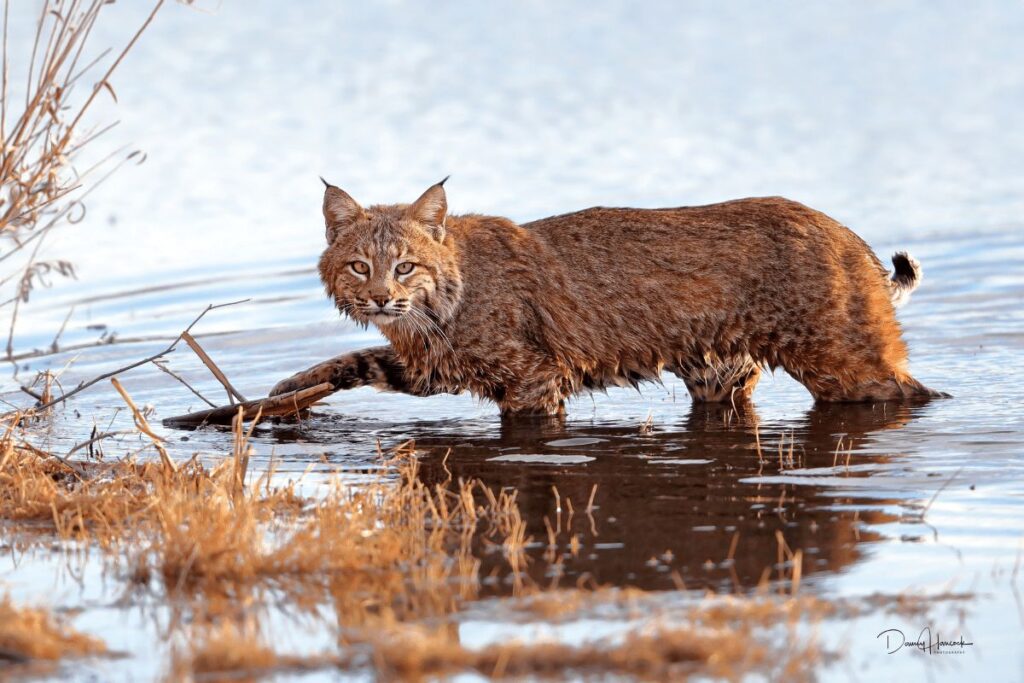
Within the Deschutes National Forest, bobcats tend to be elusive, but keen-eyed visitors might catch a glimpse of them in the denser underbrush regions, particularly around the Broken Top trailhead or the woodland sections of the Dillon Falls area. An enchanting fact about bobcats is their adaptability.
They can thrive in a plethora of habitats, from forests and swamps to urban fringes, making their range expansive and their sightings a cherished experience.
When searching for bobcats in the Deschutes National Forest, you may want to look for tracks or scat near rock outcrops and brushy areas. These animals are also known to hunt along streams, so keep an eye out while hiking through creekside trails.
Coyotes
Coyotes, with their tawny fur and alert demeanor, are the songsters of North American wilderness. Their slender frame is complemented by a bushy tail, often held low, and a pointed face featuring sharp, intelligent eyes.
Primarily carnivorous, their diet is remarkably varied—it includes rodents, rabbits, birds, and even fruits, revealing their opportunistic feeding habits.
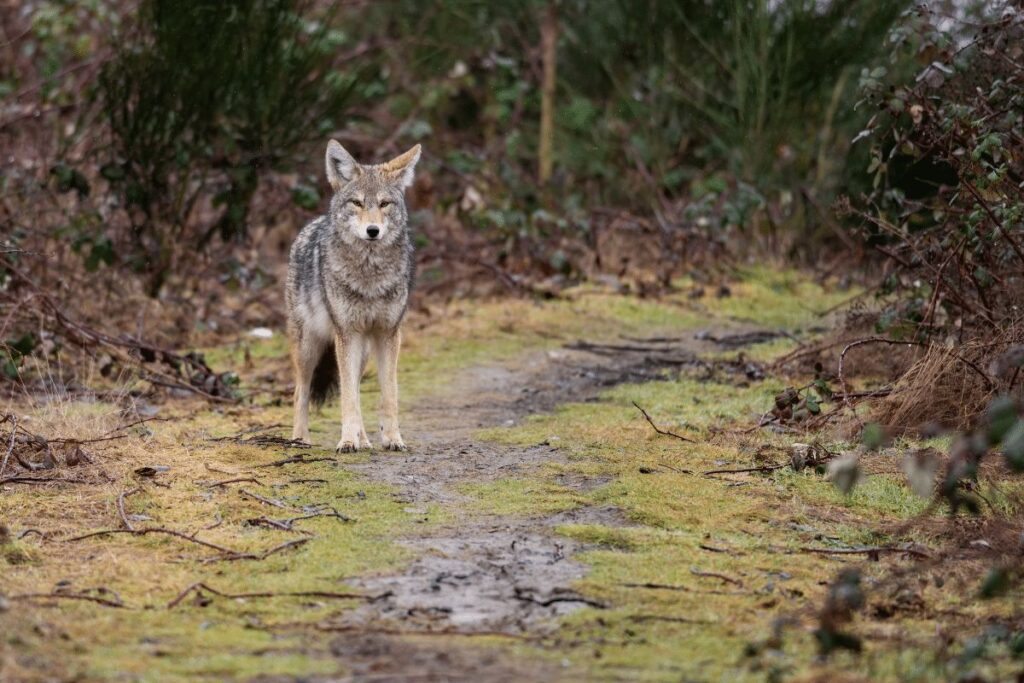
In the Deschutes National Forest, coyotes can frequently be seen during dawn or dusk, traversing meadows or woodland clearings, such as those near the Lava River Cave or the open stretches of the Newberry National Volcanic Monument.
An engrossing trait of coyotes is their vocal versatility. From yips to howls, their calls, particularly on clear nights, are a haunting and beautiful serenade that underscores the wild essence of the forest.
Cougars (Mountain lions)
Cougars, also famously known as mountain lions or pumas, are symbols of the untamed wilderness of the Americas. With their muscular build, sleek tawny fur, and arresting gaze, they are apex predators in many of their habitats.
Their long tail, often as long as three feet, aids in balance and is one of their most distinctive features.
As obligate carnivores, cougars primarily hunt deer, though they won’t shy away from smaller fare like rodents or even larger challenges like elk, showcasing their impressive hunting versatility.
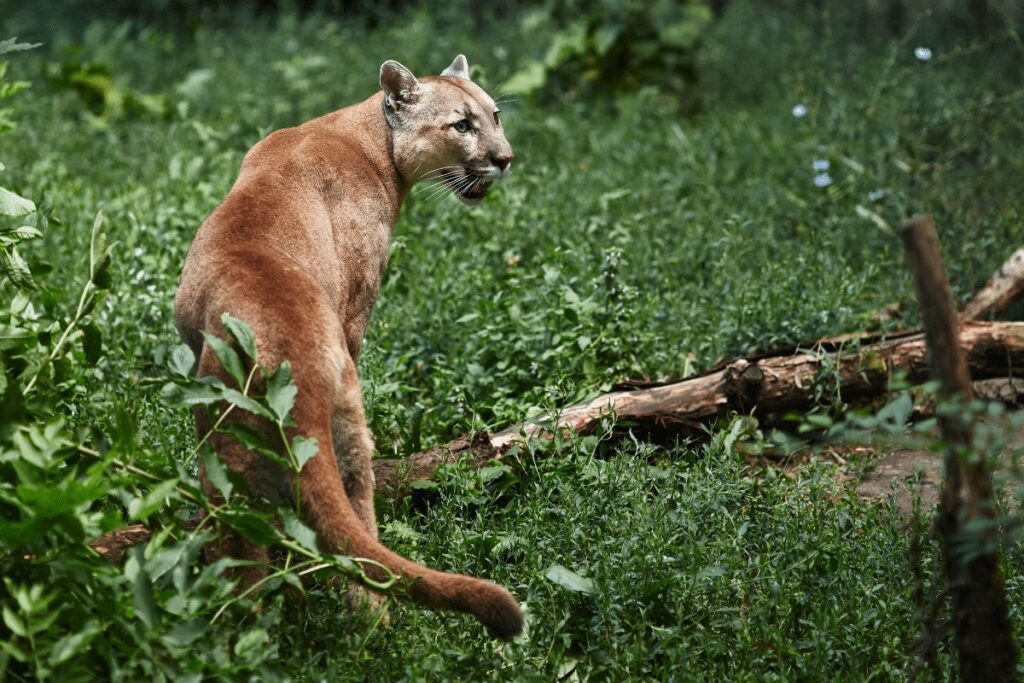
The best places to look for cougars in Deschutes National Forest are along the Middle Fork of the Deschutes River, deep within the Cascade Range or along ridgelines. In winter months, snow can provide a good opportunity to track them from their tracks and scat.
Cougars prefer the rugged and less-traversed terrains, making places like the Obsidian Trail or the remote stretches of the Three Sisters Wilderness their likely haunts.
An awe-inspiring fact about cougars is their vast territorial range, often spanning dozens of square miles, which they patrol and defend with tenacity.
Their stealth and prowess have earned them a revered status in the lore and legends of many indigenous cultures.
It’s also important to note that cougars are active year-round, so be sure to take extra precautions when heading out into the backcountry in this area.
Always keep an eye out for their tracks and be aware of your surroundings at all times.
Bald eagles
Bald eagles, with their majestic wingspan and iconic white head and tail, stand as symbols of freedom and power in the United States.
Their piercing yellow eyes and sharp hooked beak are a testament to their top-tier predator status. Primarily fish-eaters, they exhibit an unparalleled skill in swooping down onto water surfaces and snatching their prey with talon precision.
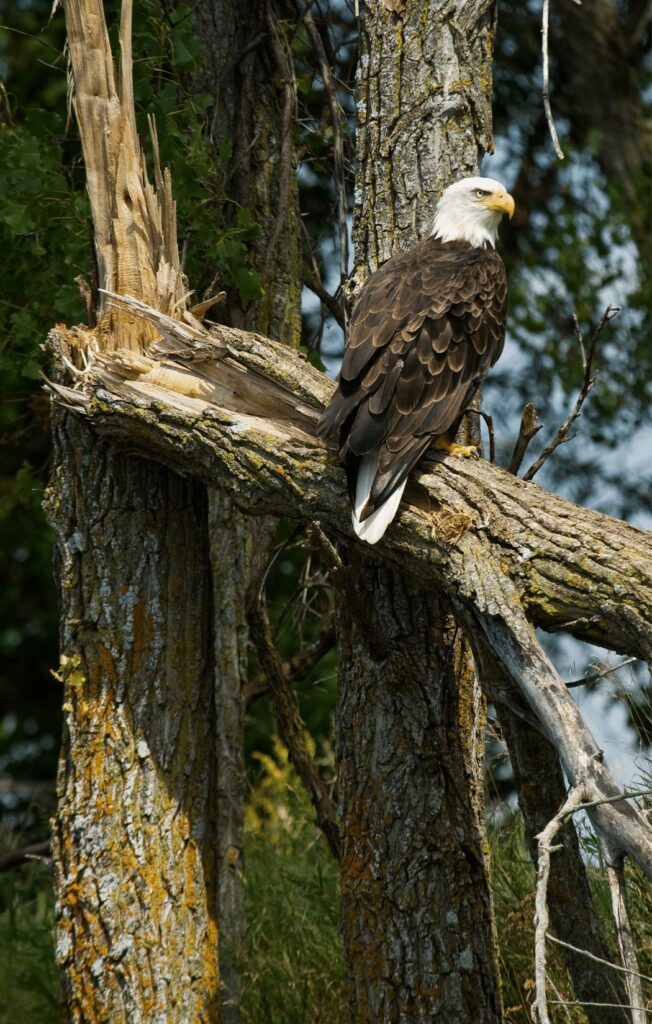
Within the Deschutes National Forest, the clear waters and abundant fish make areas like the Crane Prairie Reservoir or the banks of the Deschutes River favored hunting grounds for these raptors.
A fascinating fact about bald eagles is their nesting behavior.
They build some of the largest nests among North American birds, often returning to and expanding the same nest year after year, making them a testament to architectural endurance in the avian world.
Ospreys
Ospreys are magnificent fish-hunting raptors, often dubbed the ‘fish eagles’ of the skies. Their slender body, white underbelly, and distinct black markings on the wings and eyes make them easily distinguishable.
Adapted primarily for a piscivorous diet, their specialized talons allow them to grip slippery fish with ease, often plunging feet-first into water bodies for a successful catch.
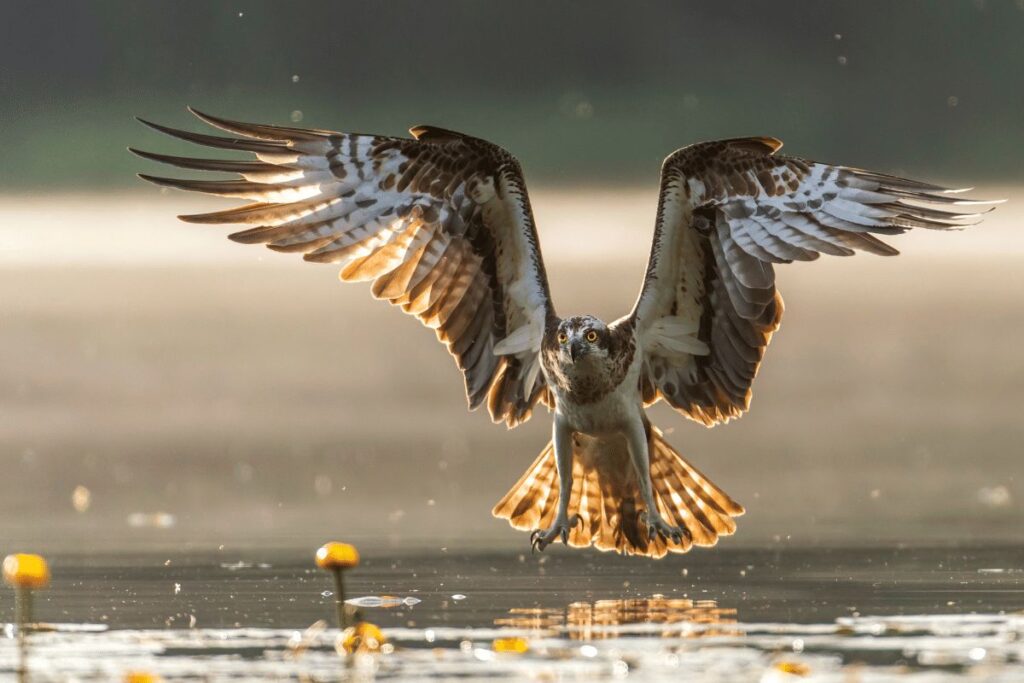
In the Deschutes National Forest, ospreys are a common sight around the Wickiup Reservoir or the Suttle Lake area, where they can be seen performing their acrobatic fishing dives.
An intriguing aspect of ospreys is their global presence. They are found on every continent except Antarctica, making them one of the most widespread birds of prey, with each region witnessing their awe-inspiring fishing prowess.
Pacific loon
The Pacific loon is a marvel of avian elegance and adaptation. With its slender profile, glossy black head, and striking throat pattern that shimmers between green and purple in different lights, it is a sight to behold.
These loons are adept divers, using their sharp beaks to capture fish and crustaceans beneath water surfaces.
In the Deschutes National Forest, though they’re less common than in coastal areas, they can occasionally be spotted in larger, deeper bodies of water, like the Crane Prairie Reservoir during their migratory periods.
An enchanting fact about the Pacific loon is its haunting and melodious call, echoing across water bodies, especially during mating seasons, creating an atmosphere of wilderness serenity.
Double-crested cormorant
The double-crested cormorant, with its sinuous neck and dark plumage, is an unmistakable presence in many North American water bodies.
Their striking yellow-orange facial skin and green eyes contrast vividly against their dark feathers. Primarily fish-eaters, these cormorants are proficient divers, often seen surfacing with a fish gripped firmly in their hooked bill.
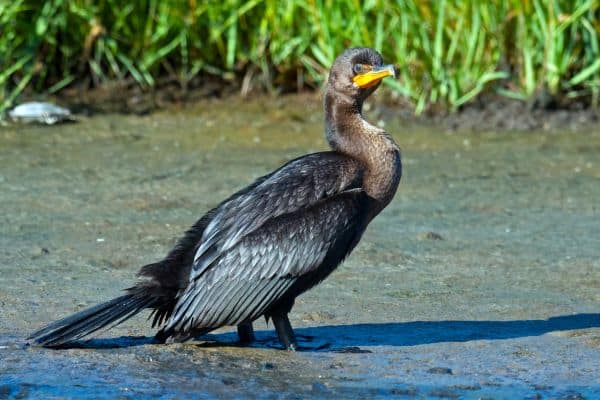
Within the Deschutes National Forest, they frequent areas rich in fish, such as the shores of the Little Lava Lake or the wetlands near Benham Falls, often perching on trees or rocks with outstretched wings to dry them.
A captivating trait of the double-crested cormorant is its namesake double crest—two tufts of feather which appear on the bird’s head during the breeding season, adding an additional layer of allure to their already impressive presence.
Common Goldeneye
The Common Goldeneye, as the name hints, has mesmerizing golden-yellow eyes that instantly command attention.
Male goldeneyes sport a glossy green-black head, a sharp white body with black back, and characteristic circular white patches in front of their eyes. Females, on the other hand, display a rich brown head with a white neckband.
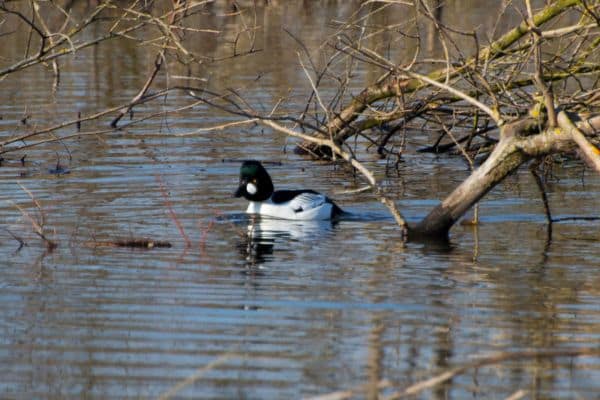
These ducks are divers, plunging into freshwater bodies to feed on aquatic insects, crustaceans, and small fish. In the Deschutes National Forest, one can frequently spot them in calm, open waters, especially near the Cascade Lakes during their migratory patterns.
Notably, the goldeneye’s nest is usually found in tree cavities, sometimes high above the ground.
Another captivating trait is their courtship display: males throw their heads back against their white-spotted backs while producing a peculiar, resonating sound.
Great Blue Heron
The Great Blue Heron stands tall and statuesque among North America’s wading birds. With a blue-gray plumage, long sinuous neck, and dagger-like bill, it presents an elegant figure whether in flight or foraging.
Often found along coastlines, marshes, and riverbanks, they hunt patiently, standing motionless for extended periods before striking rapidly to catch fish, amphibians, or small mammals.
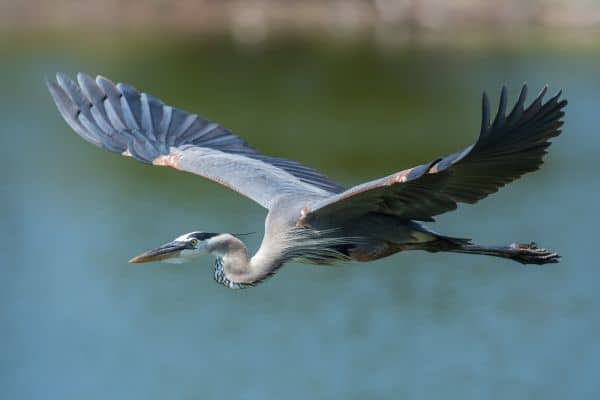
Within the Deschutes National Forest, they can be commonly observed along the wetland margins of the Deschutes River or stalking the shallows of Davis Lake.
One of the most riveting sights is their nesting behavior; they form colonies, sometimes with hundreds of nests in tall trees, offering birdwatchers an unforgettable spectacle of avian community life.
Greater Yellowlegs
The Greater Yellowlegs is a slender, elegant wader with characteristic long, bright yellow legs that give the bird its name.
They possess a sharp, slightly upturned bill, which is longer than their head, and a mottled brown-and-white body. Their distinctive, clear whistle can often be heard when they’re alarmed or in flight.
Primarily feeding on insects, crustaceans, and small fish, they exhibit a unique foraging style, often running and then suddenly stopping to catch prey.
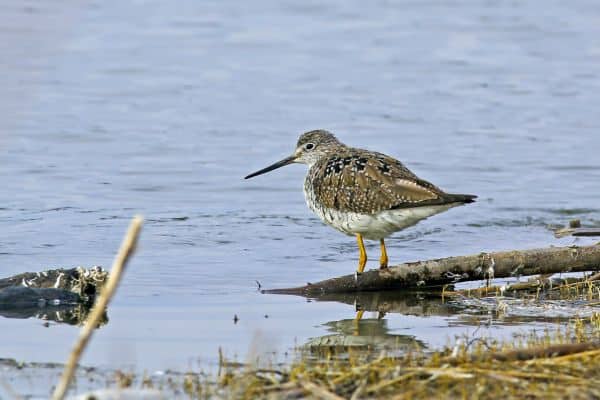
Within the Deschutes National Forest, their preferred habitats are shallow wetlands and marshy edges, making areas like the wet meadows near Tumalo Creek a potential spot for sightings.
An enthralling aspect of the Greater Yellowlegs is their migratory pattern, covering thousands of miles between their breeding grounds in the boreal forests of Canada and their wintering habitats in Central and South America.
Their long journeys are a testament to the remarkable endurance of these delicate-looking birds.
10 Wildlife Viewing Tips in Deschutes National Forest
- Prime Locations: Some of the best spots for wildlife sightings in Deschutes include the banks of the Deschutes River, the open spaces around Cascade Lakes, and the dense woodlands near Tumalo Creek.
- Dawn and Dusk: Many animals, like elk and mule deer, are most active during the early morning and late evening. Plan your hikes around these times to increase your chances of sightings.
- Stay Quiet and Patient: Wildlife can often be startled by loud noises. Move quietly, and be patient, especially if you believe an animal is nearby.
- Use Binoculars: A good pair of binoculars can help you spot and observe animals from a distance without disturbing them.
- Stay on Designated Trails: Avoid wandering off the designated paths. Not only is it safer for you, but it also ensures minimal disturbance to the animals and their habitats.
- Look for Signs: Tracks, scat, or even feeding remnants can give clues about wildlife in the area. Knowing basic tracking skills can enhance your wildlife viewing experience.
- Be Bear Aware: The forest is home to black bears. Ensure you carry bear spray, make noise while hiking, and store food securely to avoid attracting them.
- Maintain Distance: For your safety and to avoid stressing the animals, always maintain a respectable distance, especially from larger animals like cougars or elk.
- Dress Appropriately: Wear muted colors that blend into the environment. Bright colors might deter animals or make them overly curious.
- Leave No Trace: Ensure you carry out all your trash and avoid leaving food behind. A clean environment ensures the animals remain wild and reduces human-animal conflicts.
Following these tips can enhance your wildlife viewing experience in the Deschutes National Forest while ensuring the safety and well-being of both visitors and the animals.
Conclusion
Exploring Deschutes National Forest on foot is a great way to get an up-close and personal view of the animals that live in this unique ecosystem. We were fortunate enough to see 11 different species during our journey, from beautiful birds like Bald Eagles and Red-tailed Hawks to more elusive critters like Pika, Coyotes, and Mule Deer.
Not only was it a great experience for us, but also for the wild creatures we encountered along the way. Whether you’re looking for a peaceful hike or just want to observe wildlife in its natural habitat, Deschutes National Forest has plenty of opportunities for both!
FAQ:
- What animals live in Deschutes National Forest?The Deschutes National Forest is home to a diverse range of wildlife species. Some common animals you might encounter include deer, elk, coyotes, bobcats, squirrels, and numerous bird species. The forest also provides habitat for more elusive creatures like cougars, gray wolves, and various species of owls and raptors.
- Are there bears in Deschutes National Forest?Yes, there are black bears in the Deschutes National Forest. These bears are generally shy and try to avoid human contact, but it’s essential to follow bear safety guidelines if you plan to visit the forest, such as storing food properly and making noise to alert bears to your presence.
- What birds are in the Deschutes National Forest?The Deschutes National Forest boasts a rich avian population. You can spot a variety of birds, including red-tailed hawks, bald eagles, ospreys, woodpeckers, jays, and songbirds like robins and sparrows. Additionally, the forest provides a habitat for migratory birds during certain seasons.
- What animals are in Sunriver, Oregon?Sunriver, Oregon, is near the Deschutes National Forest, so you can find many of the same wildlife species in the area. This includes deer, squirrels, chipmunks, and various bird species. You may also encounter raccoons, river otters, and beavers near the Deschutes River.
- Are there snakes in Bend?Yes, there are snakes in Bend, Oregon. While Bend is known for its outdoor recreational opportunities, including hiking and biking, it’s essential to be aware that you might encounter snakes, such as garter snakes and rattlesnakes in some areas. Most are harmless, but it’s wise to exercise caution.
- Are there bears in Bend?Bears are less common in the city of Bend itself but may occasionally venture into nearby areas in search of food. It’s not unheard of to have bear sightings on the outskirts of Bend, especially if there’s a shortage of natural food sources.
- Are there wolves in Deschutes County?There have been occasional wolf sightings in Deschutes County, as gray wolves have been gradually expanding their range in Oregon. However, they are still relatively rare in the region, and sightings are infrequent.
- How many bear attacks in Big Bend?As of my last knowledge update in September 2021, there were very few reported bear attacks in Big Bend National Park in Texas. Most bear encounters in this area have been peaceful, with bears typically avoiding humans. However, it’s always crucial to follow bear safety guidelines to prevent any potential conflicts.
- Which forest has the most bears?The exact number of bears in a forest can vary widely, but some forests known for having substantial bear populations include the Great Smoky Mountains National Park, Yellowstone National Park, and the Tongass National Forest in Alaska. These areas provide ample habitat and food sources for bears.

